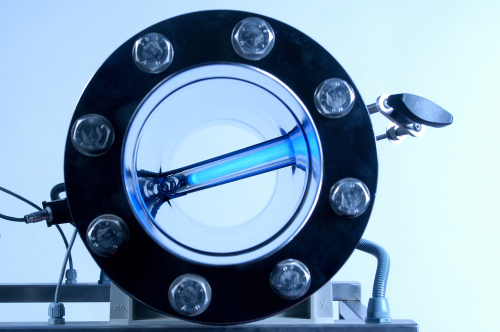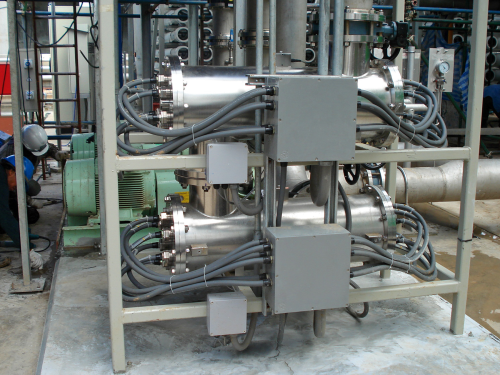

Situated in the Saraburi province, north of Bangkok, the Kaeng Khoi 2 power plant is a gas-fired thermal power plant with a generating capacity of 1468 MW - 7.5% of Thailand's total power consumption.
This gas fired, combined cycle type plant uses two 734 MW trains of combined cycle gas turbines and two heat recovery and steam generation systems, which feed one common steam turbine. The facility was designed to meet Thai and World Bank environmental regulations and the electricity generated is being sold to the Electricity Generating Authority of Thailand (EGAT) under a 25-year power purchase agreement.
The project successfully overcame a number of obstacles, including changes in the project’s fuel type from coal to natural gas and relocation from the Prachuab Khiri Khan Province to the Saraburi Province. As a result, industry observers have confidence in Thailand’s long-term strategy for expanding electricity generation. The power plant will play a vital role in meeting the country’s future electricity demand, which is expected to reach approximately 41,000 MW in 2015, based on forecast annual growth of 6-7%.
Securing operation long term
Equally important to the long term success of the project was the elimination of total organic carbon (TOC) from boiler feedwater. This is essential for a high pressure boiler's long-term operation and performance, especially for modern boilers such as the one at Kaeng Khoi 2 which has a high evaporative rate.
TOC can cause corrosion in boiler systems as the breakdown of organic compounds in heated water forms carbonic acid in the steam and condensate. Corrosion is a serious problem which can lead to the failure of critical parts of the system and overall efficiency loss. Most energy plants set maximum limits for TOC in boiler feedwater, with the level depending on the pressure of the boiler – the higher the pressure, the higher the purity requirements.
The level and type of organic material in feedwater depends on the source and can vary during the year as the seasons change. To make things more complicated, TOC is an aggregate measure of organic carbon which does not differentiate between simple low molecular weight molecules and more complex high molecular weight compounds.
Choosing a removal method
The water treatment designer has a number of tools in his armoury to remove TOC, including flocculation, filtration, ultrafiltration, reverse osmosis, ion exchange and ultra-violet (UV), each of which can remove some of the TOC, but seldom all. The designer is therefore often faced with a poorly characterised feed water quality which will vary over time, with the requirement to deliver and warranty a low TOC level from a system where no single process will guarantee the result.
A process design strategy therefore has to accommodate this uncertainty and very often relies on a combination of processes to ensure the final result. UV is one of the tools employed, offering a unique ability to break down the trace organics that cannot be removed by any of the other processes.
A typical UV system consists of a UV lamp housed in a protective quartz sleeve which is mounted within a cylindrical stainless steel chamber. The water to be treated enters at one end and passes along the entire length of the chamber before exiting at the other end.
There are two main types of UV technology, based on the type of UV lamps used: low pressure and medium pressure. Low pressure lamps have a monochromatic UV output (limited to a single wavelength at 254nm), whereas medium pressure lamps have a polychromatic UV output (with an output between 185-400nm). Medium pressure UV systems also allow a higher energy input, often required for more difficult organic compounds, in a compact package.
How UV works on TOCs
Research by Hanovia has shown that medium pressure UV works in two ways. The first action of UV on TOCs is an oxidation process caused by UV breaking down water molecules at low wavelengths. This creates hydroxyl radicals (free OH- radicals), strong oxidising agents which readily combine with other molecules, such as the hydrocarbon molecules that make up TOCs. When hydroxyls combine with TOCs they form H2O and CO2 molecules; the TOCs are destroyed and oxidation is complete.
The second type of reaction occurs when UV is absorbed directly by the organic molecules, breaking down their chemical bonds. This occurs across a wider range of wavelengths depending on the chemical bonds being broken.
This 'two pronged' attack is very effective and can result in dramatic reductions in TOC concentrations. It is particularly useful in addressing seasonally varying feed water quality, as the two mechanisms are complimentary and may address different TOC molecules. Only medium pressure UV provides this dual mechanism.
The water treatment system
The original source of the boiler feedwater at the Kaeng Khoi plant is water from a local river, which is stored in a raw water pond before being pumped into the water treatment plant. Following softening and clarifying pre-treatment, the water passes through fine sand filters and then undergoes reverse osmosis to remove total dissolved solids (TDS) before passing through two medium pressure UV chambers. Positioned in series, each chamber contains six medium pressure UV lamps. Following UV treatment, the water passes through mixed bed deionisers prior to use.
The contractors who supplied the demineralisation plant decided to use Hanovia UV technology because of the low pressure drop through the medium pressure UV chambers and the system’s overall ease of use compared with competitors’ equipment.
The two UV chambers supplied by Hanovia treat a combined water flow of up to 400m3 per hour. Actual TOC input to the UV chambers is 183ppb and output is 58ppb – a 68% reduction and well below the required minimum required concentration.
UV system requirements
The optimum location for the UV systems depends on the overall deionisation process selected, but generally it is deployed after the primary deionisation but before the polishing deionisation, as the polishing stage will be required to remove the break-down products from the UV.
The UV dose received by a TOC molecule is dependent on the energy output of the UV lamp, the flow rate of the water, the ability of the water to transmit UV (its transmittance value) and also the geometry of the treatment chamber. Proper design of the treatment chamber must take all of these factors into account. Transmittance is especially important, and is a measure of the amount of UV light absorbed or scattered by both suspended and dissolved material in the water. This can vary considerably depending on the source of the water and its level of purity, so a transmittance test should always be carried out to determine correct UV system design.
As flow rates increase, chamber size and lamp power output can be increased as required. For larger flows, multiple chambers are used, in series or in parallel, until the required degree of TOC reduction is reached.
Reliable TOC reduction requires that a minimum UV dose is applied to the water. Hanovia medium pressure UV lamps are powered by constant wattage transformers, which supply constant power to the UV lamp(s), despite fluctuations in power supply. This is especially important in regions where power supply may be intermittent or unreliable. Power switching options are available, adjusting the lamp power on-line as the water flow or the quality of the water changes. The power switching option maintains a constant, pre-determined UV dose level whilst ensuring maximum energy efficiency.
In most UV systems, an instantaneous means of monitoring UV intensity is desirable. If a minimum dose of UV energy, calculated from the maximum flow rate and taking into account the transmittance of the water, can be shown to have reached the outer surface of the treatment chamber (where the UV monitor is situated) then the necessary level of TOC reduction has taken place. The UV monitor can detect variations in the transmittance value of the water and helps to adjust the UV output accordingly, ensuring consistent UV levels at all times.






